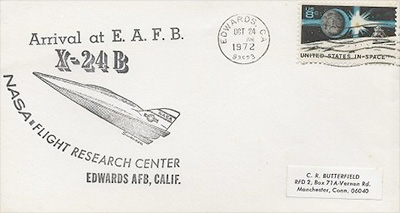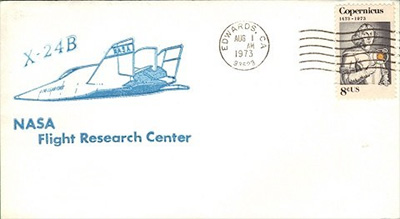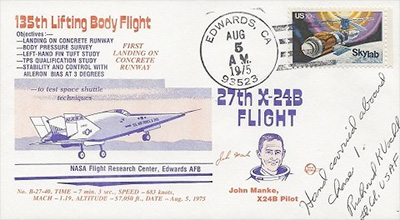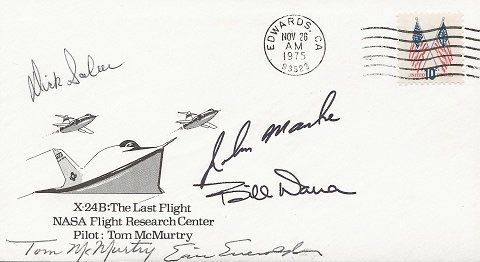Space Cover #585: The X-24B Lifting BodyAlmost 45 years ago the era of piloted lifting body research to support the design of the Space Shuttle came to an end. This week's space cover was postmarked for the last flight of the X-24B lifting body on November 26, 1975, flown by Tom McMurtry. The cachet was the last of the X-24B Edwards Exchange cachets produced for the X-24B, and it was signed by five of the six X-24B pilots (from the top going clockwise): Dick Scobee, John Manke, Bill Dana, Einar Enevoldson, and McMurtry.

In the late 1960's the Air Force came up with a new set of lifting body shapes with certain advantages over the M-2, HL-10, and X-24A lifting body aircraft then in service. The Air Force and NASA agreed to modify the X-24A into one of the new shapes, to be designated the X-24B. Where the X-24A was a short, tubby craft (potato shaped), the X-24B modification changed it to an elongated flatiron shape. The X-24B would carry the same XLR11 engine as the X-24A along with smaller landing assist rocket motors. The modifications were completed at the Martin-Marietta Denver plant and the new ship was rolled out on October 11, 1972 (covers exist). The X-24B arrived at Edwards on October 24, 1972, as commemorated on the Carl Swanson designed, rubber stamped Boy Scout cachet above. These "Boy Scout Cachets" were applied by the local scout troop at Edwards and were used throughout the X-24B program.
Once at Edwards, several ground tests were run, including "taxi tests" where the small landing rockets and the main engine were used to propel the X-24B along the ground. The taxi tests took place on July 2, 5, and 6, 1973. On July 10, 1973, a taxi test of the B52 mothership carrying the unmanned X-24B was performed. The first captive flight, unmanned, under the wing of the B52 mothership took place on July 19, 1973. Covers are known for all these events.

The first free flight occurred on August 1, 1973, flown by John Manke. The cover above was postmarked for the first free flight and carries the first of the Edwards Exchange Cachets, applied by the NASA Exchange Council at Edwards. There were five different Edwards Exchange Cachets applied through the life of the X-24B program, and the details on those just might make for a good future article.
The first rocket powered flight took place on November 15, 1973 with Manke at the controls. On the sixteenth flight, October 25, 1974, pilot Mike Love flew the X-24B to its' fastest speed of 1.76 times the speed of sound (1164 mph). The highest X-24B flight took place on May 22, 1975 when Manke reached 74,100 ft. In all missions, the X-24B handled very well.

To further examine the capabilities of the Space Shuttle to make precision unpowered landings, the X-24B became the first lifting body to land on a concrete runway on August 5, 1975, flown by Manke. All of the previous landings had taken place on the Edwards Dry Lake bed. Manke touched down precisely on the planned mark on Edwards' concrete runway. The Space Voyager cacheted cover for this flight is shown above. Space Voyager (Bob Rank) produced a new and very-informative cachet for every X-24B flight. Additionally, this cover was flown onboard the photo chase plane by Lt. Col Richard Voehl.
Late in 1975, the X-24B was flown on eight flights to check out pilots Bill Dana, Einar Enevoldson, Dick Scobee, and Tom McMurtry, concluding the program on November 26, 1975. In total the X-24B flew 36 missions in the hands of six different pilots, providing invaluable data and experience for the Space Shuttle program. Today, the X-24B can be seen in the US Air Force Museum at Dayton, Ohio.
Philatelically the X-24B program was quite well documented. As noted above covers exist for rollout, arrival, taxi tests, all of the free flights, and even some of the abort/captive flights The free flight covers exist in great abundance and variety, making X-24B flight covers a cheap, fun, and variegated way to collect covers for one of the rocketplanes and Space Shuttle precursor.
And next week, the Maestro-of-X-24B, Bob M, will follow up with more details on this lifting body.















